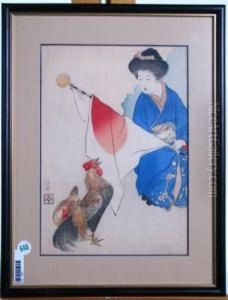Keishu Takeuchi Paintings
Keishu Takeuchi was a Japanese artist born in the year 1861 in Edo, which is present-day Tokyo, Japan. He is best known for his work as a Nihonga painter and for his contributions to the development of modern Japanese art. Nihonga is a term that refers to Japanese-style painting that was developed during the Meiji period in an effort to distinguish it from Western-style painting, which was also being introduced to Japan at the time.
Keishu was active in the Meiji and Taisho periods, a time when Japan was undergoing rapid modernization and westernization. He studied under various masters, including the renowned artist Tsukioka Yoshitoshi, who was a significant figure in the late Edo and early Meiji era. Under Yoshitoshi's guidance, Keishu honed his skills in traditional Japanese painting techniques and ukiyo-e, a genre of woodblock prints and paintings.
Throughout his career, Keishu Takeuchi embraced both traditional Japanese aesthetics and the influx of Western art methods. This combination allowed him to develop a style that was both modern and deeply rooted in Japanese artistic traditions. He became associated with the Japan Art Institute (Nihon Bijutsuin), which played a pivotal role in the creation and promotion of Nihonga.
In addition to his painting, Keishu also worked as an illustrator for newspapers and magazines, contributing to the popular culture of the time. His illustrations often depicted women and historical tales, rendered in a style that was elegant and refined yet accessible to the broader public.
Keishu's work was not only appreciated in Japan but also gained international recognition. He participated in several exhibitions abroad, helping to introduce Japanese art and aesthetics to the Western world. His art was exhibited at events such as the World's Columbian Exposition in Chicago in 1893, further establishing his reputation.
Keishu Takeuchi passed away in 1942, leaving behind a legacy that influenced the world of Japanese art. His work continues to be celebrated for its beauty and its ability to encapsulate a pivotal moment in Japan's artistic and cultural history. Keishu's life and art are reflective of a nation in transition, capturing the essence of both the preservation of tradition and the embrace of modernity.
